The only way I know of to plot two values on the same TensorBoard graph is to use two separate SummaryWriters with the same root directory. For example, the logging directories might be: log_dir/train and log_dir/eval.
This approach is used in this answer but for TensorFlow instead of pytorch.
In order to do this with the Trainer API a custom callback is needed that takes two SummaryWriters. Here is the code for my custom callback CombinedTensorBoardCallback, that I made by modifying the code for TensorBoardCallback:
import os
from transformers.integrations import TrainerCallback, is_tensorboard_available
def custom_rewrite_logs(d, mode):
new_d = {}
eval_prefix = "eval_"
eval_prefix_len = len(eval_prefix)
test_prefix = "test_"
test_prefix_len = len(test_prefix)
for k, v in d.items():
if mode == 'eval' and k.startswith(eval_prefix):
if k[eval_prefix_len:] == 'loss':
new_d["combined/" + k[eval_prefix_len:]] = v
elif mode == 'test' and k.startswith(test_prefix):
if k[test_prefix_len:] == 'loss':
new_d["combined/" + k[test_prefix_len:]] = v
elif mode == 'train':
if k == 'loss':
new_d["combined/" + k] = v
return new_d
class CombinedTensorBoardCallback(TrainerCallback):
"""
A [`TrainerCallback`] that sends the logs to [TensorBoard](https://www.tensorflow.org/tensorboard).
Args:
tb_writer (`SummaryWriter`, *optional*):
The writer to use. Will instantiate one if not set.
"""
def __init__(self, tb_writers=None):
has_tensorboard = is_tensorboard_available()
if not has_tensorboard:
raise RuntimeError(
"TensorBoardCallback requires tensorboard to be installed. Either update your PyTorch version or"
" install tensorboardX."
)
if has_tensorboard:
try:
from torch.utils.tensorboard import SummaryWriter # noqa: F401
self._SummaryWriter = SummaryWriter
except ImportError:
try:
from tensorboardX import SummaryWriter
self._SummaryWriter = SummaryWriter
except ImportError:
self._SummaryWriter = None
else:
self._SummaryWriter = None
self.tb_writers = tb_writers
def _init_summary_writer(self, args, log_dir=None):
log_dir = log_dir or args.logging_dir
if self._SummaryWriter is not None:
self.tb_writers = dict(train=self._SummaryWriter(log_dir=os.path.join(log_dir, 'train')),
eval=self._SummaryWriter(log_dir=os.path.join(log_dir, 'eval')))
def on_train_begin(self, args, state, control, **kwargs):
if not state.is_world_process_zero:
return
log_dir = None
if state.is_hyper_param_search:
trial_name = state.trial_name
if trial_name is not None:
log_dir = os.path.join(args.logging_dir, trial_name)
if self.tb_writers is None:
self._init_summary_writer(args, log_dir)
for k, tbw in self.tb_writers.items():
tbw.add_text("args", args.to_json_string())
if "model" in kwargs:
model = kwargs["model"]
if hasattr(model, "config") and model.config is not None:
model_config_json = model.config.to_json_string()
tbw.add_text("model_config", model_config_json)
# Version of TensorBoard coming from tensorboardX does not have this method.
if hasattr(tbw, "add_hparams"):
tbw.add_hparams(args.to_sanitized_dict(), metric_dict={})
def on_log(self, args, state, control, logs=None, **kwargs):
if not state.is_world_process_zero:
return
if self.tb_writers is None:
self._init_summary_writer(args)
for tbk, tbw in self.tb_writers.items():
logs_new = custom_rewrite_logs(logs, mode=tbk)
for k, v in logs_new.items():
if isinstance(v, (int, float)):
tbw.add_scalar(k, v, state.global_step)
else:
logger.warning(
"Trainer is attempting to log a value of "
f'"{v}" of type {type(v)} for key "{k}" as a scalar. '
"This invocation of Tensorboard's writer.add_scalar() "
"is incorrect so we dropped this attribute."
)
tbw.flush()
def on_train_end(self, args, state, control, **kwargs):
for tbw in self.tb_writers.values():
tbw.close()
self.tb_writers = None
If you want to combine train and eval for other metrics besides the loss then custom_rewrite_logs should be modified accordingly.
As usual, the callback goes in the Trainer constructor. In my test example it was:
trainer = Trainer(
model=rnn,
args=train_args,
train_dataset=train_dataset,
eval_dataset=validation_dataset,
tokenizer=tokenizer,
compute_metrics=compute_metrics,
callbacks=[CombinedTensorBoardCallback]
)
Also you might want to remove the default TensorBoardCallback or else in addition to the combined loss graph, the training loss and validation loss will both appear separately as it does by default.
trainer.remove_callback(TensorBoardCallback)
Here is the resulting TensorBoard view:

